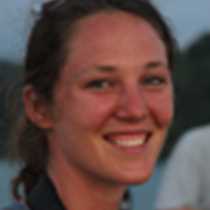Astoria, Oregon
Last night the National Geographic Sea Bird continued her way west on the Columbia River toward the destination of our final day of the voyage – Astoria. This Oregonian town of about 10,000 people sits at the mouth of the Columbia River. The entrance of the river, called the Columbia River Bar, is where the river’s current dissipates into the Pacific Ocean. It is three miles wide and six miles long and often causes large standing waves, making it a tumultuous passage. We didn’t pass through the bar, but we did venture far enough to get the look (and feel!) of the restless waters. The bar is also well known among history buffs as the place where Lewis and Clark spent the winter of 1805-1806, after their long journey west from the Mississippi River. The Corps of Discovery built a camp called Fort Clatsop at the mouth of the river, and this morning we had a chance to visit this historic site. Now a National Park Service area, the fort has been rebuilt to show visitors how Lewis and Clark and their men might have spent that winter on the banks of the Columbia River. The interpretive center at Fort Clatsop was also interesting to explore. The exhibits offered a good selection of Lewis and Clark relics as well as Native American artifacts
Upon returning from Fort Clatsop, we stopped at the Columbia River Maritime Museum in Astoria. We explored the displays and exhibits and read fascinating stories about the many shipwrecks that occurred at the mouth of the river due to the constantly shifting sandbars of the Columbia River Bar.
After a break for lunch, we had several options for afternoon activities. It was a beautiful, warm and sunny day so many guests opted to explore the town of Astoria and do some last-minute shopping. Others chose to go to the Lewis and Clark Interpretive Center at Cape Disappointment. The cape was named for the British fur trader John Meares in 1788, who sailed south along the coast in search of trade. After a storm, he turned his ship around and headed back north, missing the discovery of the Columbia River. Another group went to the Astoria Column for a scenic look over Astoria and the Columbia River; 164 spiral steps takes you to the top, but the view from ground is just as stunning.
We ended the day with recap and cocktails in the lounge. Captain Coughlin joined us for dinner, and as we sailed back to Portland, we enjoyed good conversation and shared stories from the past six days aboard the National Geographic Sea Bird.




